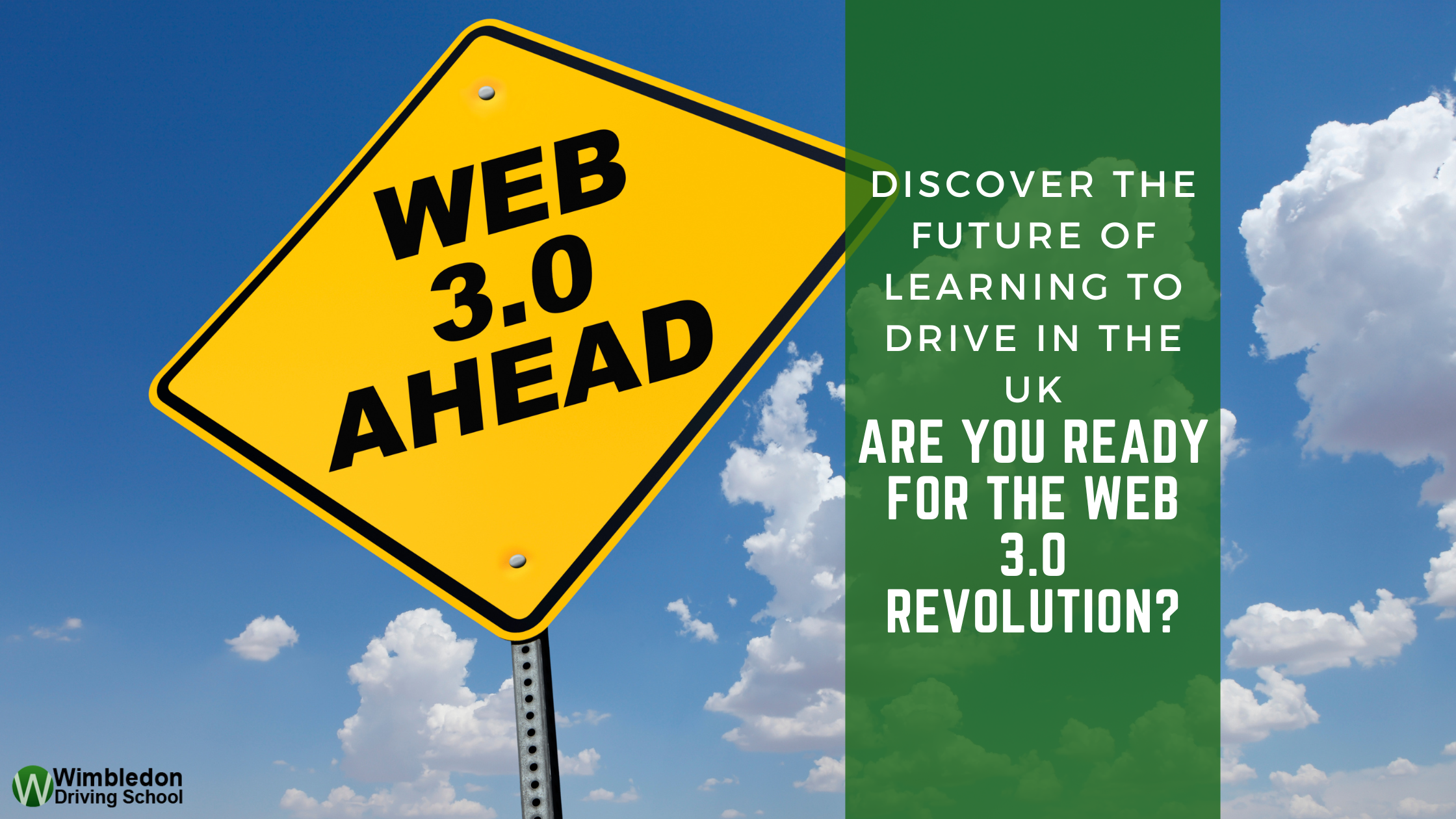Picture this: a world where learning to drive is as engaging as your favourite video game, as personalised as your morning coffee, and as safe as a seatbelt. In the UK, this vision is fast becoming a reality as the Web 3.0 revolution sweeps across the driving education landscape. But first, let’s understand what Web 3.0 is all about.
Web 3.0, also known as the Semantic Web, is the next generation of the internet where data is more interconnected, intelligent, and personalised. With the integration of advanced technologies such as Artificial Intelligence, Internet of Things (IoT), and blockchain, Web 3.0 promises to create a more intuitive and immersive online experience. As we embrace this new era, the driving education sector in the UK is set to undergo a significant transformation. Are you ready to join this exciting journey?
I. A New Era in Driving Education: Why Settle for Less?
Imagine a world where learning to drive is transformed by cutting-edge technologies, making the experience more engaging, personalised, and effective. This is the promise of Web 3.0, and it’s already beginning to reshape the way learner drivers in the UK hit the road. Are you prepared to be part of this thrilling evolution?
II. Virtual Reality (VR) and Augmented Reality (AR): The Ultimate Driving Simulator
A. Welcome to the Future of Driving Education
What if you could practice your driving skills in a safe, realistic virtual environment, complete with real-time feedback and personalised instruction? This is the world that Virtual Reality (VR) and Augmented Reality (AR) are opening up for learner drivers in the UK. Are you ready to experience it for yourself?
B. Embracing the Benefits of VR and AR in Driving Education
Both Virtual Reality (VR) and Augmented Reality (AR) have the potential to revolutionise driving education by providing immersive, interactive learning experiences. By leveraging these cutting-edge technologies, learner drivers can gain valuable practice and develop crucial skills in a safe, controlled environment.
Virtual Reality (VR)
VR creates a fully immersive, computer-generated environment that can simulate real-world driving scenarios. This technology can benefit driving education in several ways:
- Safety: Learners can practice their driving skills in a risk-free environment without exposing themselves or others to real-life hazards.
- Controlled scenarios: Driving schools can create specific, controlled situations for learners to practice, allowing them to focus on mastering individual skills or tackling challenging situations.
- Stress reduction: VR can help learners build their confidence in a controlled setting, reducing the stress and anxiety associated with real-world driving.
Augmented Reality (AR)
AR superimposes computer-generated images, sounds, and other sensory information onto the real world, enhancing the learner’s field of view with additional information. This technology can enhance driving education in various ways:
- Guided practice: By overlaying visual cues and instructions onto the learner’s field of view, AR can help guide their actions, ensuring correct driving techniques are followed.
- Interactive road signs and traffic signals: AR can provide a dynamic way to learn about road signs and traffic signals by displaying them contextually in real-time, helping learners better understand their meaning and importance.
- Real-time hazard detection: With the help of AR, learners can be alerted to potential hazards such as pedestrians, cyclists, and other vehicles, helping them develop better situational awareness and decision-making skills.
As VR and AR technologies continue to advance, driving schools will need to adapt and incorporate them into their curriculum to stay competitive and provide the best learning experience for their students. By embracing these technologies, learners can benefit from a more engaging, personalised, and effective driving education, preparing them for the real-world challenges they will face on the road.
III. AI-Driven Personalised Learning: A Roadmap to Success, Tailored Just for You
A. Meet Your Personal Driving Guru: Artificial Intelligence
What if a virtual driving instructor could analyse your driving patterns, identify areas for improvement, and provide customised lessons and suggestions? That’s the potential of AI-driven personalised learning, and it’s set to revolutionise driving education in the UK.
B. AI: Your Key to Unlocking Mastery
Unlock the benefits of AI-driven personalisation:
- Individualised learning: Why follow a one-size-fits-all approach when you can have a learning plan tailored to your unique needs and strengths?
- Efficiency: How much faster could you progress if you focused on the areas that need improvement?
- Real-time adjustments: Wouldn’t it be great to have lessons and feedback adapt to your performance, ensuring continuous improvement?
C. The AI-Powered Driving School: A Reality in the UK
As AI technology becomes more accessible, UK driving schools are leveraging its power to provide personalised learning experiences for their students. Are you ready to harness the power of AI in your driving journey?
IV. Connected Cars and the Internet of Things (IoT): The Symphony of the Road
A. The Ultimate Driving Orchestra
Picture a harmonious orchestra, where each instrument communicates seamlessly with the others to create a beautiful symphony. That’s the future of driving in the UK, thanks to the Internet of Things (IoT) and connected cars.
B. IoT: Enhancing Driver Training with Connected Technologies
The Internet of Things (IoT) is a network of interconnected devices that communicate with each other to exchange data and make intelligent decisions. In the context of driving education, IoT can offer several advantages by providing a more connected, data-driven learning experience:
- Real-time performance monitoring: IoT-enabled sensors in vehicles can collect data on various aspects of driving, such as speed, braking, steering, and fuel consumption. This data can be used to provide real-time feedback to learners, helping them improve their driving skills more efficiently.
- Smart road infrastructure: IoT devices embedded in road infrastructure, such as traffic lights, road signs, and parking meters, can communicate with connected cars to provide essential information to learners. This can help them better understand traffic patterns, rules, and regulations, as well as adapt their driving behaviour accordingly.
- Vehicle-to-vehicle communication: Connected cars can also communicate with each other, providing valuable information about road conditions, traffic, and potential hazards. This can help learners develop better situational awareness and decision-making skills.
As IoT technology continues to advance and become more integrated into the driving experience, it will play an increasingly crucial role in driving education. Driving schools will need to adopt these connected technologies to provide a comprehensive, future-proof learning experience for their students.
V. Gamification and Immersive Learning Experiences: Level Up Your Driving Skills
A. The Ultimate Driving Adventure
What if learning to drive was as thrilling as conquering a new level in your favourite video game? Gamification techniques are set to bring this excitement to driving education in the UK, transforming the learning process into an engaging and interactive experience.
B. Mastering the Game of Driving
These interactive learning platforms may offer a range of features, including:
- Progress tracking: Earn rewards and achievements as you improve your driving skills.
- Competitive elements: Challenge yourself by competing with other users to reach the top of the leaderboard.
- Varied scenarios: Test your skills in diverse driving situations, from congested city streets to winding country roads.
C. UK Driving Schools Get Their Game On
As gamification proves its effectiveness in driving education, UK driving schools are beginning to incorporate these techniques into their programmes, making the learning process more enjoyable and engaging.
VI. Access to Expert Knowledge and Community Support: Learn from the Best, Wherever You Are
A. The Global Classroom
Imagine having access to a global community of driving experts, resources, and support at your fingertips. Web 3.0 enables this interconnected world, giving UK learner drivers the opportunity to learn from the best, wherever they are.
B. Worldwide Expertise at Your Fingertips
With access to a wealth of expert knowledge, UK learner drivers can:
- Study the best practices: Learn from top driving instructors and researchers worldwide.
- Access diverse resources: Benefit from a wide range of learning materials, including interactive videos, quizzes, and simulations.
- Stay up-to-date: Keep abreast of the latest developments in driving technology and safety.
C. Peer-to-Peer Learning and Mentorship Opportunities
Web 3.0 also facilitates peer-to-peer learning and mentorship, allowing UK learner drivers to connect with other students, exchange tips and experiences, and support each other throughout their learning journey.
VII. Challenges and Considerations: Navigating the Road Ahead
A. Regulatory Adjustments
As these emerging technologies become more prominent, UK regulators will need to adapt rules and guidelines to ensure their safe and effective integration into driving education.
B. Infrastructure Investments
To fully leverage the potential of Web 3.0 in driving education, investments in technological infrastructure, such as high-speed internet connections and advanced training equipment, will be crucial.
C. Changing Social Attitudes
For Web 3.0 to truly revolutionise driving education in the UK, social attitudes towards learning to drive may need to shift, embracing innovation and collaboration as the new norm.
VIII. Conclusion: Driving into a Brighter Future
Web 3.0 offers tremendous opportunities for transforming driving education in the UK. By tapping into the capabilities of cutting-edge technologies like VR, AR, AI, and IoT, and promoting enhanced collaboration and customisation, the future of driving instruction in the UK is evolving.






